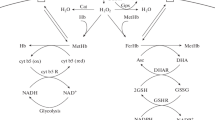Abstract
The susceptibility of human, cow, pig, sheep and rabbit erythrocytes to free radicals (peroxyl radicals) generated in vitro by 2,2′-azo-bis(2-amidinopropane) hydrochloride (AAPH) was evaluated by means of a haemolysis test and expressed as the time to 50% of maximal haemolysis (HT50). The most sensitive to damage by free radicals appeared to be the erythrocytes of pigs and sheep, their HT50 values being (mean±SEM) 85.1±1.28 min and 89.0±1.31 min, respectively. Human erythrocytes and those of cows and rabbits were about twice as resistant, their HT50 values being (mean±SEM) 174.3±1.53 min, 181.2±1.22 min and 183.4±2.54 min, respectively. Pig and sheep erythrocytes used in the haemolysis test provided an indication of the antioxidant status in a shorter time (2.5 h versus 4.5 h) than those of the other species studied. The results indicate that the HT50 test may be a convenient alternative to the osmotic resistance test for defining the antioxidant resistance of erythrocytes.
Similar content being viewed by others
REFERENCES
Amoako, K.K., Goto, Y., Misawa, N., Xu, D.L. and Shinjo, T., 1997. Interactions between Fusobacterium necrophorum hemolysin, erythrocytes and erythrocyte membranes. FEMS Microbiology Letters, 150, 101-106
Amoako, K.K., Goto, Y., Misawa, N., Xu, D.L. and Shinjo, T., 1998. The erythrocyte receptor for Fusobacterium necrophorum hemolysin: phosphatidylcholine as a possible candidate. FEMS Microbiology Letters, 168, 65-70
Blache, D., Prost, M. and Raffi, J., 1991. In vitro biological test of resistance to oxidation: application to identification of irradiated food. In: Potential New Methods of Detection of Irradiated Food, (Commission of the European Communities, Luxembourg), 105-116
Brzezińska-Ślebodzińska, E., 2001. Erythrocyte osmotic fragility test as the measure of defence against free radicals in rabbits of different age. Acta Veterinaria Hungarica, 49, 413-419
Brzezińska-Ślebodzińska, E., Miller, J.K., Quigley, J.D. III, Moore, J.R. and Madsen, F.C., 1994. Antioxidant status of dairy cows supplemented prepartum with vitamin E and selenium. Journal of Dairy Science, 77, 3087-3095
Brzezińska-Ślebodzińska, E., Miller, J.K., Campbell, M.H., Holt, J.A. and Mosley, S.A., 1999. Antioxidant status of dairy cows fed vitamin E or excess Fe prepartum. FASEB Journal, 13, A565, Abstract 446.19
Chan, J.Y., Kwong, M., Lo, M., Emerson, R. and Kuypers, F.A., 2001. Reduced oxidative-stress response in red blood cells from p45NFE2-deficient mice. Blood, 97, 2151-2158
Devasena, T., Lalitha, S. and Padma, K., 2001. Lipid peroxidation, osmotic fragility and antioxidant status in children with acute post-streptococcal glomerulonephritis. Clinica Chimica Acta, 308, 155-161
El-Missiry, M.A. and Abou-Seif, M., 2000. Photosensitization induced reactive oxygen species and oxidative damage in human erythrocytes. Cancer Letters, 158, 155-163
Galleano, M. and Puntarulo, S., 1995. Role of antioxidants on the erythrocytes resistance to lipid peroxidation after acute iron overload in rats. Biochimica et Biophysica Acta, 1271, 321-326
Girodon, F., Blache, D., Monget, A.-L., Lombart, M., Brunet-Lecompte, P., Arnaud, J., Richard, M.-J. and Galan, P., 1997. Effects of a two-year supplementation with low doses of antioxidant vitamins and/or minerals in elderly subjects on levels of nutrients and antioxidant defense parameters. Journal of the American College of Nutrition, 16, 357-365
May, J.M., Qu, Z.C. and Mendiratta, S., 1998. Protection and recycling of alfa-tocopherol in human erythrocytes by intracellular ascorbic acid. Archives of Biochemistry and Biophysics, 349, 281-289
Miller, J.K., Brzezińska-Ślebodzińska, E., Campbell, M.H., Mosley, S.A. and Holt, J.A., 1999. Vitamin and mineral involvement in antioxidants. Proceedings of the 50th California Animal Nutrition Conference, Fresno, 79-85
Nelson, D.A. and Davey, F.R., 1991. Erythrocytic disorders. In: J.B. Henry (ed.), Clinical Diagnosis Management by Laboratory Methods, (W.B. Saunders, London), 627-676
Niki, E., Yamamoto, Y., Komuro, E. and Sato, K., 1991. Membrane damage due to lipid oxidation. American Journal of Clinical Nutrition, 53(Supplement), 201S-205S
Oyewale, J.O., 1991. Osmotic fragility of erythrocytes of West African dwarf sheep and goats: effects of temperature and pH. British Veterinary Journal, 147, 163-170
Oyewale, J.O., 1992. Changes in osmotic resistance of erythrocytes of cattle, pigs, rats and rabbits during variation in temperature and pH. Journal of Veterinary Medicine, A39, 98-104
Pond, W.G. and Houpt, K.A., 1978. The Biology of the Pig, (Cornell University Press, London), 251-254
Reiter, R.J., 1995. Oxidative processes and antioxidative defense mechanisms in the aging brain. FASEB Journal, 9, 526-533
Schalm, O.W., Jain, N.C. and Carroll, E.J., 1975. In: Veterinary Haematology, 3rd edn, (Lea and Febiger, Philadelphia)
Scott, M.D., Lubin, B.H., Zuo, L. and Kuypers, F.A., 1991. Erythrocyte defense against hydrogen peroxide: preeminent importance of catalase. Journal of Laboratory and Clinical Medicine, 118, 7-16
Stern, A., 1986. Red cell oxidative damage. In: H. Sies (ed.), Oxidative Stress, (Academic Press, London), 331-349
Tatum, V. and Chow, C., 1996. Antioxidant status and susceptibility of sickle erythrocytes to oxidative and osmotic stress. Free Radical Research, 25, 133-139
Tereo, K. and Niki, E., 1986. Damage to biological tissues induced by radical initiator 2,2′-azobis(2-amidinopropane) dihydrochloride and its inhibition by chain-breaking antioxidants. Journal of Free Radicals in Biology and Medicine, 2, 193-201
Tilzer, L.L. and DeMott, W.R., 1990. Hematology. In: D.S. Jacobs and W.L. Wolfson (eds), Laboratory Test Handbook, (Williams and Wilkins, Baltimore), 506-508
Velasquez-Pereira, J., McDowell, L.R., Risco, C.A., Prichard, D., Martin, F.G., Calhoun, M.C., Williams, S.N., Wilkinson, N.S. and Ogebe, P., 1998. Effects of performance, tissue integrity, and metabolism of vitamin E supplementation for beef heifers fed a diet that contains gossypol. Journal of Animal Science, 76, 2871-2884
Wagner, G.M., Lubin, B.H. and Chiu, D.T.-Y., 1988. Oxidative damage to red blood cell. In: C.K. Chow (ed.), Cellular Antioxidant Defense Mechanisms, vol. 1, (CRC Press, Boca Raton, FL), 185-195
Author information
Authors and Affiliations
Rights and permissions
About this article
Cite this article
Brzezińska-Ślebodzińska, E. Species Differences in the Susceptibility of Erythrocytes Exposed to Free Radicals In Vitro . Vet Res Commun 27, 211–217 (2003). https://doi.org/10.1023/A:1023344607691
Issue Date:
DOI: https://doi.org/10.1023/A:1023344607691




